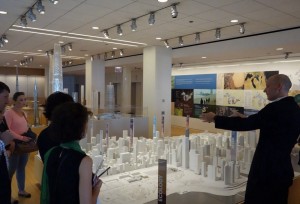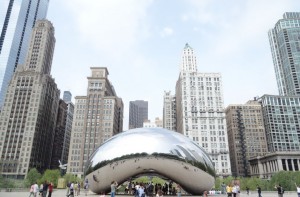After a well-needed rest, Day 3 began with the group rushing off to begin our first series of Chicago practice visits. Before we go on to tell you about the practices we visited, it is worth mentioning that by this stage, we had a developed understanding of both the way in which the built environment developed within the city, which was further iterated in the meeting of the four practices. SOM The first practice we met with was
SOM.
For those that aren’t aware – SOM are one of the largest and most influential practices within Chicago and across America, and have been in practice since 1936. They have had much to do with the development of the city, and have sky scrapers scattered across Chicago. Doug at SOM ran us through current projects related to the city, most notably their work with the redevelopment of the millenium Park – furthering the Burnham Plan of Chicago which was undertaken in 1909. The main focus was furthering the connection between the city and the lakefront. We were taken for a tour throughout the park, which we all agreed was a brilliant piece of urban design – reinforcing why SOM have had such influence on the development of the city over the years.
PORT
The next practice we visited was the very talented Andrew Moddrell of PORT, in his office in the Monadnock building (the tallest full masonry building). From the beginning Andy was very engaging, particularly given many of us could relate to him as directors of young practices. Andy ran through many of his innovative and highly creative urban design propositions, most notably his Denver City Park City Loop project (definitely worth following this hyperlink!) Andy was also very generous with his time, taking us on a walk down Dearborn St- a street on which Mies’ post office complex sits alongside many influential chicago architecture projects.
WHEELER KEARNS
Across the road from the Monadnock building sits the practice of Wheeler Kearns. Dan Wheeler took us through their practice, explaining their method of practice. It was great to see the hand made iterative models that the practice use; and we were equally as enamoured with the large plate of gummy bears on the meeting room table arrival. Dan also pulled us out of the office for another walk down Dearborn St; during which he told us further architectural anecdotes, building on the story of the city and furthering developing our understanding of this place.
STUDIO GANG
Our last visit for the afternoon was the office of Studio Gang. We were shown a body of works that the practice had undertaken, it was interesting to note the practice took on projects irrespective of typology and scale – the practice was interested in developing projects with a design potential. It was great to see the extensive materiality research, and the use of models in the design development of the projects. What was most notable about visiting each of these practices was the passion and knowledge they held for their cities Architecture. This was evident in their enthusiasm to take us outside, to walk down the street and to point out their favourite buildings.



